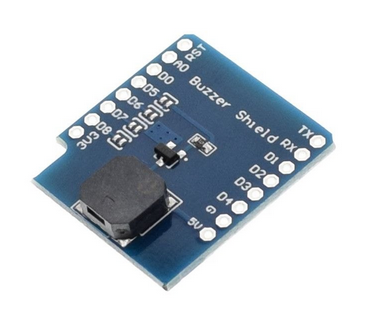The Buzzer shield
The Hardware
The buzzer shield implements a passive buzzer with frequencies up to 1 kHz - 3 kHz. By default it uses data line D5 corresponding to GPIO 14 (GPIUO 18 on the ESP32) but can be configured to a different GPIO line. In order to make the device work a solder bridge for the data line must be installed ( see the 4 double solder blobs on the left hand side of the module. One of these pairs of blobs must be connected).
In order to make the device work a solder bridge for the data line must be installed ( see the 4 double solder blobs on the left hand side of the module. One of these pairs of blobs must be connected).
The software
The buzzer needs a frequency passed to it through a GPIO line (by default the upper solder pair blobs connected corresponding to D5 or GPIO 14. To test the device I wrote a very simple micro Python script sending a 500 Hz square wave to it. This can easily be done through the micro Python PWM class. Here is the code: https://iotworkshop.africa/pub/AFNOG/BuzzerShield/firstTest.py.txt Dave Hylands has written some micro Python buzzer scripts You first select the tune you want to hear. Pushing the "Play tune" button will send the number of the tune in the list to the Cayenne MQTT broker, which will pass it on to the cayenneBuzzer.py program to play it.
--
You first select the tune you want to hear. Pushing the "Play tune" button will send the number of the tune in the list to the Cayenne MQTT broker, which will pass it on to the cayenneBuzzer.py program to play it.
-- Comments
| I | Attachment | History | Action | Size | Date | Who | Comment |
|---|---|---|---|---|---|---|---|
| |
QtBuzzer.png | r1 | manage | 22.8 K | 2019-05-17 - 15:46 | UliRaich | |
| |
esp8266Buzzer.py.txt | r1 | manage | 0.7 K | 2019-04-05 - 15:05 | UliRaich | |
| |
firstTest.py.txt | r1 | manage | 0.2 K | 2019-04-05 - 15:05 | UliRaich | |
| |
rtttl.py.txt | r1 | manage | 3.8 K | 2019-04-05 - 15:05 | UliRaich | |
| |
songs.py.txt | r1 | manage | 6.2 K | 2019-04-05 - 15:05 | UliRaich | |
| |
wemosBuzzer.png | r1 | manage | 101.1 K | 2019-03-22 - 14:15 | UliRaich |
Ideas, requests, problems regarding TWiki? Send feedback



